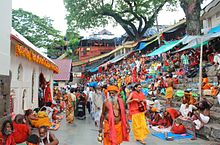Ambubachi Mela
| Ambubachi Mela | |
|---|---|
Hindus | |
| Type | Religious, folk |
| Date | Middle of June |
| Frequency | annual |
| Part of a series on the |
| Culture of Assam |
|---|
 |
The Ambubachi Mela (/ˈæmbʊˌbɑ:ʧɪ,ˌ æmbʊˈbɑ:ʧɪ ˈmeɪlə, mi:lə/) is an annual Hindu
Ambubachi Mela is the celebration of the yearly menstruation course of goddess Kamakhya.[5] It is believed that the presiding goddess of the temple, Devi Kamakhya, the Mother Shakti, goes through her annual cycle of menstruation during this time stretch.[6] It is also believed that during the monsoon rains, the creative and nurturing power of the 'menses' of Mother Earth becomes accessible to devotees at this site during the mela. There is no idol of the presiding deity but she is worshipped in the form of a yoni-like stone instead over which a natural spring flows.[5][6]
Tantric fertility festival
This mela is also known as Ameti or Tantric fertility festival since it is closely associated with Tantric Shakti cult prevalent in eastern parts of India. Even some Tantric Babas make their public appearances only during these four days. The rest of the year, they remain in seclusion. Some Babas are seen displaying their psychic powers like putting their heads in a pit and stand upright on it, standing on one leg for hours at a stretch.[7]
The mela

The temple remains closed for three days during the mela On the fourth day the devotees are allowed to enter the temple and worship devi Kamakhya.
The prasad
The
Pilgrims

Every year lakhs of pilgrims, starting from
See also
- Assamese Culture
- Raja Parva
- Shaktism
References
- ^ "639 Identifier Documentation: aho – ISO 639-3". SIL International (formerly known as the Summer Institute of Linguistics). SIL International. Retrieved 29 June 2019.
Ahom [aho]
- ^ "Population by Religious Communities". Census India – 2001. Ministry of Home Affairs, Government of India. Retrieved 1 July 2019.
Census Data Finder/C Series/Population by Religious Communities
- ^ "Population by religion community – 2011". Census of India, 2011. The Registrar General & Census Commissioner, India. Archived from the original on 25 August 2015.
2011census/C-01/DDW00C-01 MDDS.XLS
- ^ "Ambubachi Puja and Mela 2015 at Kamakhya Temple". 19 June 2015. Archived from the original on 19 June 2015. Retrieved 19 June 2015.
- ^ a b c d e f g h i Chawla, Janet (16 September 2002). "Celebrating The Divine Female Principle". Boloji.com. Archived from the original on 31 January 2010. Retrieved 24 December 2009.
- ^ a b c d e f "Ambubachi Fair". Bharatonline.com. Archived from the original on 6 January 2010. Retrieved 24 December 2009.
- ^ a b c d e f Admin (17 September 2009). "A Mystic Festival To Draw Thousands". 360degreeworld.com. Archived from the original on 24 October 2009. Retrieved 24 December 2009.
